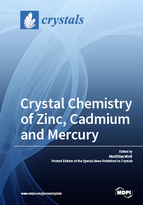Crystal Chemistry of Zinc, Cadmium and Mercury
A special issue of Crystals (ISSN 2073-4352). This special issue belongs to the section "Inorganic Crystalline Materials".
Deadline for manuscript submissions: closed (31 October 2017) | Viewed by 61462
Special Issue Editor
Interests: synthesis of inorganic materials; solid state chemistry; crystallography; phase transitions; oxido compounds
Special Issues, Collections and Topics in MDPI journals
Special Issue Information
Dear Colleagues,
The closed-shell nd10(n+1)s2 (n = 3,4,5) electronic configuration of group 12 elements (zinc, cadmium, mercury) defines their respective physical and chemical behaviors. Hence, for some properties, zinc and cadmium compounds resemble their alkaline earth congeners (likewise with closed-shell configurations) rather than their transition metal relatives, whereas mercury and its compounds are unique amongst all metals, which, to a certain extent, can be attributed to relativistic effects. All these features are also reflected in the characteristic crystal chemistry of the zinc triad elements and their compounds, including simple inorganic salts, alloys, compounds with inorganic framework structures, compounds with molecular structures or coordination polymers and hybrid compounds.
We invite investigators working in a wide range of disciplines to submit articles or communications which discuss the crystal chemistry of zinc, cadmium, or mercury compounds. This includes examples of experimentally determined crystal structures using powder or single crystal diffraction techniques, structures determined by other methods (like spectroscopy) or by computational chemistry. The topics listed as keywords are considered only as broad examples; this special issue is open for a much greater number of topics or sub-topics.
Prof. Dr. Matthias Weil
Guest Editor
Manuscript Submission Information
Manuscripts should be submitted online at www.mdpi.com by registering and logging in to this website. Once you are registered, click here to go to the submission form. Manuscripts can be submitted until the deadline. All submissions that pass pre-check are peer-reviewed. Accepted papers will be published continuously in the journal (as soon as accepted) and will be listed together on the special issue website. Research articles, review articles as well as short communications are invited. For planned papers, a title and short abstract (about 100 words) can be sent to the Editorial Office for announcement on this website.
Submitted manuscripts should not have been published previously, nor be under consideration for publication elsewhere (except conference proceedings papers). All manuscripts are thoroughly refereed through a single-blind peer-review process. A guide for authors and other relevant information for submission of manuscripts is available on the Instructions for Authors page. Crystals is an international peer-reviewed open access monthly journal published by MDPI.
Please visit the Instructions for Authors page before submitting a manuscript. The Article Processing Charge (APC) for publication in this open access journal is 2600 CHF (Swiss Francs). Submitted papers should be well formatted and use good English. Authors may use MDPI's English editing service prior to publication or during author revisions.
Keywords
-
synthesis and crystal structures of zinc, cadmium or mercury compounds
-
framework structures
-
molecular compounds
-
coordination polymers and molecular self-assembly
-
mineral phases
-
amalgams
-
relativistic effects
-
spectroscopy
-
computational methods






